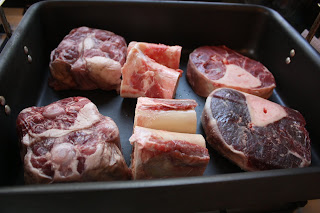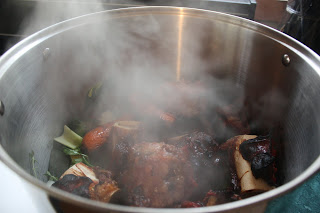The main reason I made that
beef stock the other day was so that I could make French Onion soup. Last year, when I made beef stock for the first time, I had been inspired by Thomas Keller's French Onion soup recipe, but life events conspired in such a way that I never did get to make the soup, and I ended up freezing the stock for use in other recipes during the year, like my (inauthentic but still delicious)
spaghetti bolognese,
mushroom wine sauce, pot roast, crockpot chili and beef stew.
Well, the vision of that French Onion soup never left me, and I knew that I was going to make it with the freshest batch of beef stock I could, and let me just start by saying, I felt that it was totally worth the 14 hours it took me on Monday to make the stock, plus the 5-hour caramelization time for the onions yesterday.
I think that time is of equal importance in developing the flavor. I read that "the difference between a home cook and a professional chef is that the latter has the guts to keep the dish on the fire longer to get that extra flavor." -
from Chowhound
This recipe fulfills that requirement. I started prepping at 8:30 am and ate my first bowl of this soup at 4:15 pm. Well worth the wait.
I did not keep faithfully to Keller's recipe, mostly by accident (I totally forgot to add the flour), and I halved it since I would be the only one eating it and my freezer is jam-packed with various stocks and containers of other soups, but it was still far and away the best French Onion soup I've ever had.
I started with 4 lb. of sweet onions, Maya Sweets from Peru, though I'd have used vidalias if they'd been in stock. Peel the onions, cut them in half through the root and then slice thinly widthwise. Toss them into your largest dutch oven (I used my 7-quart pot) along with 1 tablespoon of olive oil and 4 tablespoons of salted butter and cook over very low heat, stirring to incorporate the melted butter and olive oil evenly. Stir occasionally, every 15 minutes or so.
As you can see, at the 1-hour mark, the volume of the onions has reduced significantly:
Still at the 1-hour mark, the onions will have released a great deal of moisture. Keep stirring every 15 minutes or so and keep the heat low so that it does not simply brown without caramelizing or, worse yet, burn. It will seem very slow going. That's what we want.
After 2 hours, the onions have really reduced to just a fraction of what they had been and most of that moisture has evaporated and you might noticed a slight bit of coloration.
Also, after 2 hours, the onions start to get creamy.
Keep stirring every 15 minutes.
At 3 hours, oddly enough, the onions looked a lot like they did at the 2-hour mark, but the kitchen smelled much more strongly of that sweet smell of onions slow cooking. At this point, I started to check the onions more frequently, every 10 minutes, and stirring when needed.
When you stir, you'll notice a buildup of the sugary juices from the onions on the bottom of the pot. Watch that carefully, because that is where any browning and burning will begin. In my experience, that gets to be like a chain reaction, once it starts to burn, it moves VERY QUICKLY, and there is no recovering from scorched foods.
At the 3 ½ hour mark, a real change in color. There may be a few spots which are a little bit darker, which is ok, as long as you keep a watchful eye and be diligent about stirring every 10 minutes. I scraped up the film on the bottom to incorporate it back into the onions and keep it from burning. It seemed to work.
4 hours in, the onions are a deeper brown color and quite sticky and sweet. I tasted some. Even after 4 hours of cooking, they still had some bite to them, so another hour to soften is a good thing.
4 ½ hours in, a bit darker, and much stickier. At this point, for the last hour or so, I am in the kitchen prepping everything else and stirring pretty frequently and checking that it does not burn.
5 hours later... a mess of sticky, sweet, caramelized onions lounging on the bottom of the pot. Only 5 hours earlier, the onions had filled this pot to nearly the top. How magically simple, just applying low heat and time.
For the soup, reserve ¾ cup of the caramelized onions - store the remainder in the fridge or freezer for future use.
Make the croutons: preheat the oven to 450° F. Slice up a baguette into ½ inch rounds, pour some olive oil into a bowl and add 1 teaspoon of granulated garlic and brush both sides of the bread with the garlicky oil. Place the rounds on a baking sheet lined with aluminum foil, parchment paper or a baking mat and toast for 10 minutes, then take out, flip over and bake another 5 minutes or so or until golden brown.
See? Lovely garlicky croutons.
Prepare your herb sachet by placing 2 bay leaves, 4 or 5 sprigs of fresh thyme and 8 black peppercorns into a cheesecloth bag.
Place the ¾ cup of caramelized onions in a 3-quart soup pot,
* (See Notes) add 1½ quarts of beef stock, 2 teaspoons of sea salt and the herb sachet. Bring to a boil and let simmer uncovered for an hour and a half or until reduced to about 3 cups.
Season with ¼ teaspoon of sherry vinegar, though I'm betting balsamic or champagne vinegar would be nice too. Ladle into oven-proof soup bowls, top with the croutons and shredded cheese: Emmenthaler, Comte or even Gruyuere. Ideally, you'd pop this under the broiler until the cheese melts and browns, but I don't really have a broiler (long story there), so I stuck it in a 400° F oven for 10 minutes.
French Onion Soup
Ingredients:
- 4 lb. sweet onions, sliced thinly
- 4 tablespoons salted butter
- 1 tablespoon olive oil
- 1½ quarts of beef stock
- 2 bay leaves
- 3 - 4 sprigs fresh thyme
- 8 black peppercorns
- cheesecloth
- 1 tablespoon flour * See Notes
- 1 tablespoon sea salt
- ¼ teaspoon of sherry vinegar
- French baguette, sliced into ½ inch rounds
- olive oil
- granulated garlic
- shredded Emmenthaler cheese
Directions:
- In your largest dutch oven or a large stock pot, melt the butter and olive oil and add the onions. Lower the heat to the lowest setting and stir the onions every 15 minutes.
- After the 1-hour mark, the onions will have reduced in volume and released a lot of moisture. Keep stirring every 15 minutes and let the onions slow-caramelize for another 4 hours, stirring every 15 minutes until they really start to change in color, then stir every 10 minutes to be sure that they don't burn.
- Once the onions have cooked down and caramelized, make the croutons: Preheat oven to 450° F. Pour some olive oil into a bowl and add 1 teaspoon of granulated garlic and brush both sides of the bread with the garlicky oil. Place the rounds on a baking sheet lined with aluminum foil, parchment paper or a baking mat and toast for 10 minutes, then take out, flip over and bake another 5 minutes or so or until golden brown.
- Place the bay leaves, thyme and peppercorns into your cheesecloth bag.
- Reserve ¾ cup of the caramelized onions for the soup. Keep the remainder in the fridge or freezer for other recipes or a second batch of this soup. Place the onions in a 3-quart soup pot over medium heat, add the flour and and stir until incorporated. Add the beef stock, salt and sachet, bring to a boil and then reduce heat to low and let simmer uncovered for an hour and a half or until reduced to about 3 cups.
- Season to taste with more salt and pepper and add ¼ teaspoon of sherry vinegar, and ladle into oven-proof bowls. Top with croutons and shredded cheese and stick under the broiler until browned and bubbly.
Notes:
- Keller's recipe calls for a bit of flour stirred in with the caramelized onions before the addition of the stock but I just completely forgot about it. I was still pleased with the end result and I am not usually a huge fan of flour-thickened soups anyway.























































